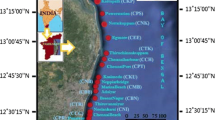Abstract
In all 43 sediment samples were collected as gravity cores in depthfrom 70 to 150 cm, from the 20 sampling sites of the continental slope ofthe southern part of the Black Sea, during 1978. The samples were quantitativelyanalyzed by radioisotope excited energy dispersive X-ray fluorescence spectrometry(EDXRF) using fundamental parameter technique (FTP). The investigated sedimentsamples were the organic rich-mud components of the core samples, which wereknown as rich in metals. The metal concentration ranges were as follows: Ca(3.1–12.9%), Ti (1000–2000 µg/g), V (40–150 µg/g),Cr (30–200 µg/g), Mn (200–1500 µg/g), Ni (25–100µg/g), Cu (20–70 µg/g), Zn (20–50 µg/g), Br(15–670 µg/g), Rb (5–90 µg/g), Sr (80–700 µg/g),Y (10–20 µg/g), Mo (10–111 µg/g), Zr (20–190µg/g), Cd ( <1–5 µg/g), Sb ( <1–5 µg/g),I (10–430 µg/g), Ba (100–1650 µg/g), La (5–18µg/g), Ce (12–38 µg/g) and Nd (6–17 µg/g). Thesediment cores systematically collected in 1978 by Mineral Research and ExplorationInstitute of Turkey (MTA) are the oldest available sediment samples from theTurkish coastline of the Black Sea. Therefore, the results may be used asreferences for monitoring possible future metal pollution.
Similar content being viewed by others
References
E. T. Degens,F. Khoo,W. Michaelis, Nature, 269 (1977) 566.
E. T. Degens,D. A. Ross (Eds), The Black Sea-Geology, Chemistry and Biology, Am. Assoc. Pet. Geol., Tulsa (USA), 1974.
T. Akyuz,A. Bassari,T. Saltoglu,T. Kurtcebe, Toxicol. Environ. Chem., 48 (1995) 125.
P. M. van Dyck,R. E. van Grieken, Anal. Chem., 52 (1980) 1859.
R. D. Giauque,R. B. Garrett,L. Y. Goda, Anal. Chem., 51 (1979) 511.
J. Omote,H. Kohno,K. Toda, Anal. Chim. Acta, 307 (1995) 117.
T. Akyuz,S. Akyuz,A. Bassari, J. Radioanal. Nucl. Chem., 227 (1998) 43.
IAEA-AQCS, Catalogue Reference Materials and Intercomparison Exercises, IAEA, Vienna (1998/ 1999).
D. A. Ross,E. T. Degens,J. C. Mac ILvaine, Science, 170 (1970) 163.
T. Saltoglu,A. Gedik,N. Cagatay,H. Kaplan,N. Tulu,V. Toker, Investigations of Black Sea Dip Sediments, Mineral Research and Exploration Institute Report Ankara, Turkey, 1986, (in Turkish).
M. N. Bodur,M. Ergin, Chem. Geol., 115 (1994) 73.
G. Evans,H. Erten,S. N. Alavi,H. R. Von-Gunten,M. ERGIN, Geo-Mar. Lett., 9 (1989) 27.
H. F. Shaw,P. R. Bush, Mar. Geol., 27 (1978) 115.
H. J. Rosler,H. Lunge, Geochemical Tables, Elsevier Pub. Co., Amsterdam, 1972, p. 295.
I. A. Breger, The role of the organic matter in accumulation of uranium; the organic geochemistry of the coal-uranium association, in: Formation of Uranium Ore Deposits, IAEA-SM-183/29, IAEA, Vienna, 1974, p. 99.
I. I. Volkov,L. S. Fomina, Influence of Organic Material and Processes of Sulfide Formation on Distribution of Some Trace Elements in Deep-Water Sediments of Black Sea, in: E. T. Degens andD. A. Ross (Eds), The Black Sea Geology, Chemistry and Biology, Am. Assoc. Pet. Geol., Tulsa (USA), 1974, p. 456.
Author information
Authors and Affiliations
Rights and permissions
About this article
Cite this article
Bassari, A. Radioisotope excited EDXRF analysis of sediment core samples from the southern part of the Black Sea +. Journal of Radioanalytical and Nuclear Chemistry 250, 129–137 (2001). https://doi.org/10.1023/A:1013284701952
Issue Date:
DOI: https://doi.org/10.1023/A:1013284701952




